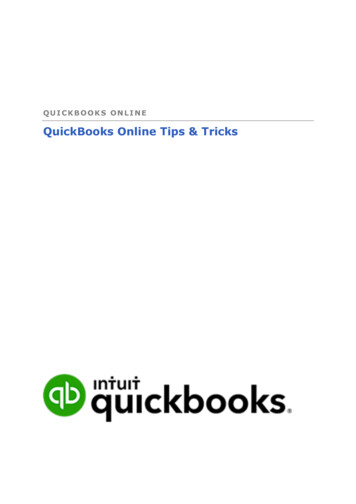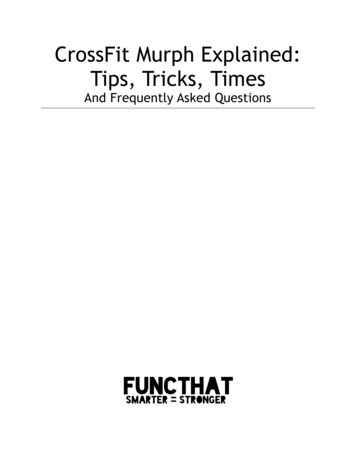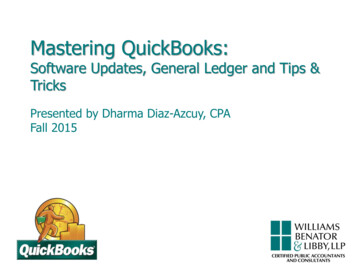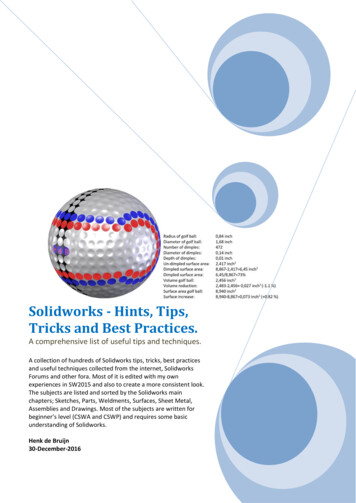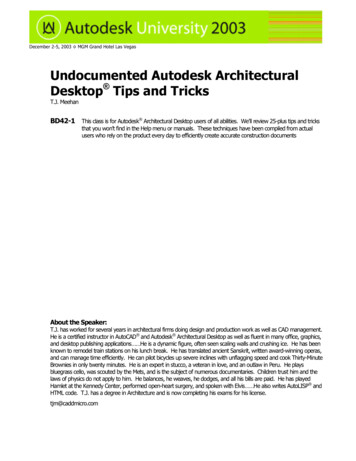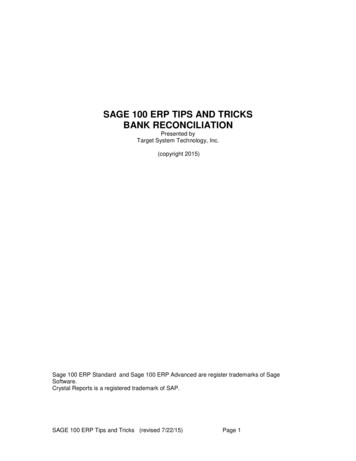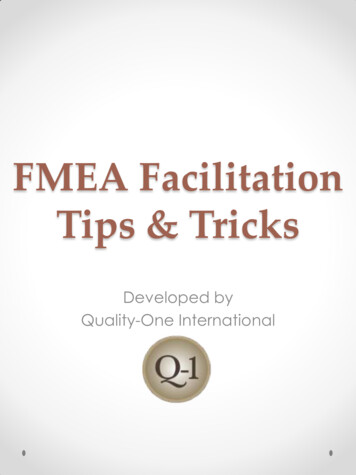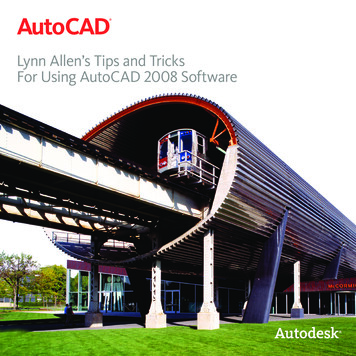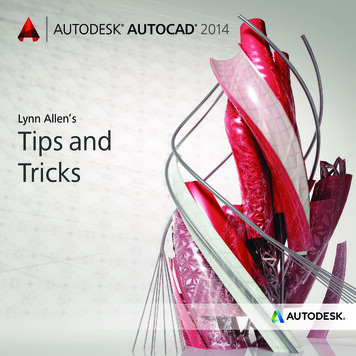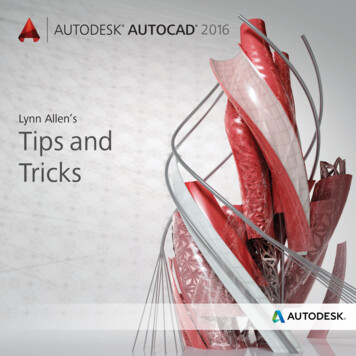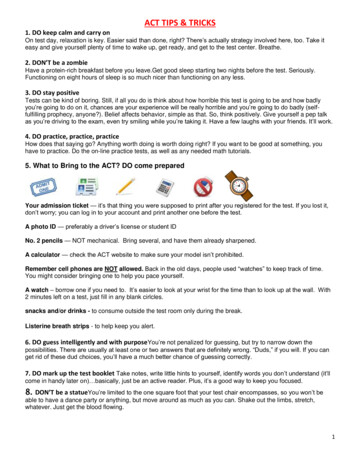
Transcription
ACT TIPS & TRICKS1. DO keep calm and carry onOn test day, relaxation is key. Easier said than done, right? There’s actually strategy involved here, too. Take iteasy and give yourself plenty of time to wake up, get ready, and get to the test center. Breathe.2. DON’T be a zombieHave a protein-rich breakfast before you leave.Get good sleep starting two nights before the test. Seriously.Functioning on eight hours of sleep is so much nicer than functioning on any less.3. DO stay positiveTests can be kind of boring. Still, if all you do is think about how horrible this test is going to be and how badlyyou’re going to do on it, chances are your experience will be really horrible and you’re going to do badly (selffulfilling prophecy, anyone?). Belief affects behavior, simple as that. So, think positively. Give yourself a pep talkas you’re driving to the exam, even try smiling while you’re taking it. Have a few laughs with your friends. It’ll work.4. DO practice, practice, practiceHow does that saying go? Anything worth doing is worth doing right? If you want to be good at something, youhave to practice. Do the on-line practice tests, as well as any needed math tutorials.5. What to Bring to the ACT? DO come preparedYour admission ticket — it’s that thing you were supposed to print after you registered for the test. If you lost it,don’t worry; you can log in to your account and print another one before the test.A photo ID — preferably a driver’s license or student IDNo. 2 pencils — NOT mechanical. Bring several, and have them already sharpened.A calculator — check the ACT website to make sure your model isn’t prohibited.Remember cell phones are NOT allowed. Back in the old days, people used ―watches‖ to keep track of time.You might consider bringing one to help you pace yourself.A watch – borrow one if you need to. It’s easier to look at your wrist for the time than to look up at the wall. With2 minutes left on a test, just fill in any blank cirlcles.snacks and/or drinks - to consume outside the test room only during the break.Listerine breath strips - to help keep you alert.6. DO guess intelligently and with purposeYou’re not penalized for guessing, but try to narrow down thepossibilities. There are usually at least one or two answers that are definitely wrong. ―Duds,‖ if you will. If you canget rid of these dud choices, you’ll have a much better chance of guessing correctly.7. DO mark up the test booklet Take notes, write little hints to yourself, identify words you don’t understand (it’llcome in handy later on) basically, just be an active reader. Plus, it’s a good way to keep you focused.8. DON’T be a statueYou’re limited to the one square foot that your test chair encompasses, so you won’t beable to have a dance party or anything, but move around as much as you can. Shake out the limbs, stretch,whatever. Just get the blood flowing.1
Tips for Taking the ACT Prepare your backpack the night before:This assures you that you have everything you need for the test andkeeps you calm in the morning by having everything nicely organized.o If you are driving to the test, make sure your car keys are in a location that is easy to find.Memorize the directionsBEFORE TEST DAY! (See below). During the test, you won’t get extra time to read thedirections, so if you take 5 minutes to figure out what to do, that’s 5 fewer minutes you’ll have to get points.Read each question carefully. A math diagram may show an x on the side of a triangle, but ask for perimeter.Pace yourself—don't spend too much time on a single passage or question.Use a soft lead No. 2 pencil with a good eraser. Do not use a mechanical pencil or ink pen.Answer the easy questions first; then go back and answer the more difficult ones if you have time remaining.On difficult questions, eliminate as many incorrect answers as you can, then make an educated guess.Answer every question.There is no penalty for guessing.Pay attention to the announcement of five minutes remaining on each test. Go back to questions younarrowed down earlier, and guess from the remaining choices. Then just pick a letter (NOT C) to fill in for anyremaining questions.o Letter of the Day As counter-intuitive as it may seem, you will pick up more points consistently if youalways guess the same letter. Contrary to popular opinion, you won’t get more questions right if you guess(C) rather than any other choice (in fact, C seems to be the least likely answer on the last (hardest)questions of the mast test). Go crazy, guess (A) or (F) on the next ACT you take. Just be consistento Exception: “cannot be determined from the information given” is virtually never the answerfor the math section.If you complete a test before time is called, recheck your work on that section of the test.Mark your answers properly. Erase any mark completely and cleanly without smudging.Do not mark or alter any ovals on a test or continue writing the essay after time has been called. If you do, youwill be kicked out and your answer document will not be scored.Test Booklet InstructionsThe following instructions are printed on the cover of the multiplechoice test booklet. The instructions for the ACT Writing Test are different. This booklet contains tests in English, Mathematics, Reading, and Science. These tests measure skills andabilities highly related to high school course work and success in college. CALCULATORS MAY BE USED ON THEMATHEMATICS TEST ONLY.The questions in each test are numbered, and the suggested answers for each question are lettered. On theanswer document, the rows of ovals are numbered to match the questions, and the ovals in each row arelettered to correspond to the suggested answers.For each question, first decide which answer is best. Next, locate on the answer document the row of ovalsnumbered the same as the question. Then, locate the oval in that row lettered the same as your answer.Finally, fill in the oval completely. Use a soft lead pencil and make your marks heavy and black. DO NOT USEINK OR A MECHANICAL PENCIL.Mark only one answer to each question. If you change your mind about an answer, erase your first markthoroughly before marking your new answer. For each question, make certain that you mark in the row ofovals with the same number as the question.Only responses marked on your answer document will be scored. Your score on each test will be based only onthe number of questions you answer correctly during the time allowed for that test. You will NOT be penalizedfor guessing. IT IS TO YOUR ADVANTAGE TO ANSWER EVERY QUESTION EVEN IF YOU MUST GUESS.You may work on each test ONLY when your test supervisor tells you to do so. If you finish a test before time iscalled for that test, you should use the time remaining to reconsider questions you are uncertain about in thattest. You may NOT look back to a test on which time has already been called, and you may NOT go ahead toanother test. To do so will disqualify you from the examination.Lay your pencil down immediately when time is called at the end of each test. You may NOT for any reason fillin or alter ovals for a test after time is called for that test. To do so will disqualify you from the examination.Do not fold or tear the pages of your test booklet.DO NOT OPEN THIS BOOKLET UNTIL TOLD TO DO SO.2
ACT MATH STRATEGIESTake two passes on the ACT Math test Pass 1: Start with Question 1 and work your way forward, answering questions that look relatively quickand easy and jumping over those that look difficult or time-consuming.Pass 2: After you’ve answered all the quick and easy questions, circle back to the first question youskipped over and work your way forward to the end again.o Don’t guess at any answers while you’re still on the first pass (see the previous section, ―Take twopasses on the ACT Math test,‖ where I discuss tackling the test in two separate passes). Instead,begin guessing on your second pass of the test. At this point, if you can confidently rule out acouple of answers but don’t know how to proceed with a question, you can save time by guessingat the answer and moving on to the next question.o Keep track of the questions that you guess on. If you have time at the end of the math test, you canrevisit these questions and make a more educated guess.Solve the problem first, then locate your answer, rather than plugging each option into the problem –UNLESS you have no idea how to solve it, and you have completed all the questions you know how to do–then plug in answers to find the correct one.Use all of the time provided.Go back and check your work. If nothing else, check any problems you weren’t particularly sure of.Use scratch paper to figure stuff out. Label diagrams and Draw pictures, and simplify algebraicexpressions.DON’T spend more than one minute on any problem on your first tour through the exam. The test isdesigned to give you plenty of time, but don’t waste any minutes early on. You are better off missing onehard problem than not getting to four easy problems at the end of the test.DON’T do any complicated computations that need a calculator. A calculator isn't required, so if yoursolution absolutely depends on one, you are probably headed down a time-consuming and incorrect path.DON’T leave any questions unanswered. Even if you have no idea what the question means, you shouldgive it your best shot, and then just bubble something in. You have a small chance of guessingcorrectly, and incorrect guesses aren’t penalized.If two answers look similar (positive and negative of the same number, or reciprocals), the correctanswer is probably one of them.The instructions say the drawings are not necessarily to scale, but they generally are. You can use this tomake an educated guess if you are stuck, or see if your answer looks reasonable, but not as proof.Pre-AlgebraPre-algebra questions are generally about being able to perform simple operations on wholenumbers, integers, fractions, and decimals. This includes exponents, roots, taking the absolute value, and orderinglists of numbers from least to greatest.You must be able to: Compute greatest common multiplesFind simple probabilityFind factorsFind ratios, proportions, and percents Recognize small primesRecognize patterns that describe a sequenceSolve simple linear equationsElementary AlgebraElementary algebra introduces variables, and you’ll mostly be tested on how to usethem in a variety of equations and expressions.You should be: Comfortable using equations to relate two variablesAble to solve linear and quadratic equations and linear inequalitiesAble to add and factor polynomials, as well as solve for their rootsAble to substituteFamiliar with order of operations to simplify expressions involving variables3
Intermediate AlgebraIntermediate algebra involves solving more complicated problems.You must be familiar with: Binomials2x2 matricesThe quadratic formula LogarithmsRadical and rationalexpressions Complex numbersYou also must be able to: Solve a quadratic equation by factoringSolve systems of equationsRecognize patterns in sequencesSolve equations involving absolute value and inequalities (both linear and quadratic)Plane Geometry:Plane geometry involves recognizing shapes that lie on a plane.You will be tested on: TrianglesTrapezoids RectanglesCircles ParallelogramsPolygonsYou should understand: What angles are and what their measurements can beGeneral proof technique should also be familiar to youHow to compute the surface areas and volumes of simple 3D shapesBasic postulates and definitions about parallel and perpendicular linesNames of simple 3D shapes should be knownThe basic ways to translate, rotate, and reflect a shape to obtain a congruent shapeGeneral facts about congruent triangles used in proofHow to compute perimeters and areas of 2D shapesCoordinate Geometry:Coordinate geometry involves familiarity with and the use of the standard (x, y)coordinate plane (a.k.a. the Cartesian plane). You must be familiar with labeling points in the plane. Familiaritywith the real number line, inequalities, and number line graphs are also prerequisites.You must be able to: Graph functionsDetermine slopes of linesRecognize and graph the equations for points, lines, polynomials, and circlesCompute distances between pointsRecognize the equations of parallel and perpendicular linesUnderstand the transformations: translation, rotation, and reflectionCalculate midpoints of line segmentsUnderstand the relationship between graphs and functionsAnd you should be familiar with: The graphs and equations of the three major types of conic sections: ellipses, hyperbolas, and parabolasPerforming transformations of these equationsTrigonometryYou must know: How to solve trig equationsHow to model simple situations with trig functionsHow to recognize trig graphsThe values and properties of the trig functionsThe trig identitiesHow to use the trig functions to solve for lengths of sides and angles within right triangles4
ACT SCIENCE STRATEGIESACT Science Trick #1: Read the Data Representation Passages First: On the ACT Science test, you'll seethree different types of passages: Data Representation, Conflicting Viewpoints, and Research Summaries. DataRepresentation passages are the easiest because they incorporate the least amount of reading. They basicallyask you to interpret coordinating tables, draw inferences from graphics, and analyze other diagrams and figures. Insome cases, you can go straight to the first DR question and answer it correctly without reading any explanatorymaterial whatsoever. You may just have to refer to one chart! So it makes sense to get as many points as ispossible right out of the gate by answering those questions first.A Helpful Reminder: You'll know it's a Data Representation passage if you see several large graphics like charts,tables, diagrams and graphs. If you see a lot of reading in paragraph format, you're not readi
Answer the easy questions first; then go back and answer the more difficult ones if you have time remaining. . passes on the ACT Math test,‖ where I discuss tackling the test in two separate passes). Instead, begin guessing on your second pass of the test. At this point, if you can confidently rule out a couple of answers but don’t know how to proceed with a question, you can save time .

